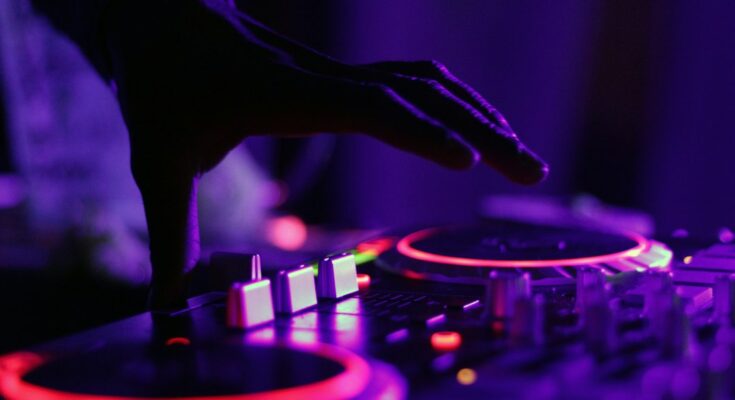The genre of synthwave music, which first gained popularity in the late 2000s and early 2010s, is distinguished by its nostalgic & futuristic sound. In particular, the electronic and synth-pop genres of 1980s music served as inspiration for it. Often linked to the retro-futuristic style, which blends elements of the past and present to produce a singular visual and aural experience, is synthwave music. The roots of synthwave music can be found in the underground electronic music scene, where musicians started experimenting with drum machines and synthesizers to produce an 80s-inspired sound.
Key Takeaways
- Synthwave music is a genre that emerged in the early 2000s, characterized by its retro-futuristic sound and aesthetic.
- The genre is heavily influenced by the music and culture of the 1980s, and has been embraced by a growing community of fans and artists.
- Synthesizers and digital audio workstations have played a key role in shaping the sound of synthwave music, allowing artists to create complex and layered compositions.
- Synthwave pioneers and influencers include artists like Kavinsky, Mitch Murder, and Com Truise, who have helped to define the genre and inspire a new generation of musicians.
- Key characteristics of synthwave music include its use of vintage synthesizers, driving rhythms, and nostalgic melodies, while retro-futuristic visuals are a key part of the genre’s aesthetic.
The groundwork for the later-emerging Synthwave genre was laid by these early pioneers of the genre, including Kavinsky and College. The comeback of 1980s pop culture is one of the main reasons for the popularity of synthwave music. The 1980s’ cinema, music, and style have all seen a rise in popularity recently. The appeal of synthwave music, which offers a contemporary reimagining of the sounds and aesthetics of that era, has been fueled by this nostalgia for the past. The popularity of synthwave music has also been greatly influenced by the retro-futurism aesthetic, which blends elements of the past and future. Neon lights, futuristic cityscapes, & a feeling of longing for a future that never materialized are characteristics of this aesthetic.
Due to its pulsating synths, intense basslines, and ethereal melodies, synthwave music effectively embodies this style. Digital audio workstations (DAWs) & synthesizers have been instrumental in creating the sound of synthwave music. Analog and digital synthesizers are the main instruments utilized in this genre. They enable musicians to produce the distinctive synthwave sounds, like the evocative gated reverb effect, shimmering arpeggios, & warm, rich analog synths.
Synthwave music production has also seen a revolution thanks to digital audio workstations. Artists can easily record, edit, and mix their music with the help of these software programs. They offer a large selection of virtual instruments and effects that can be used to produce the distinctive textures and sounds of synthwave music.
DAWs have democratized the production process by enabling artists to create excellent music from the comfort of their homes, increasing the diversity of voices within the genre. The success of the synthwave genre was made possible by its early pioneers, including Mitch Murder, College, and Kavinsky. These musicians were among the first to play around with the sounds & style of the 1980s, resulting in music that reflected the spirit of the time while incorporating contemporary elements. Their music developed an internet cult following, and modern Synthwave artists continue to be influenced by them.
Global Synthwave artists are now part of a flourishing global community. Pop culture has benefited greatly from the popularity of artists such as FM-84, Gunship, and The Midnight, among others. While adhering to the fundamental sound and style of the genre, these musicians continue to push the boundaries of synthwave music by fusing elements from other genres like rock, pop, & hip-hop. Rock, synth-pop, & electronic music are all blended together to create the unique sound of synthwave.
Pulsating synthesizers, intense basslines, & memorable melodies are the main components of synthwave music. The genre also frequently employs vocoders, gated reverb, and arpeggios. Synthwave music frequently conjures up feelings of optimism, longing, & nostalgia in terms of mood and themes.
It takes listeners to a fast-paced, futuristic world of neon lights and limitless possibilities that never was. Retro-futuristic cityscapes and VHS-inspired imagery are common visuals that accompany the music, adding to the overall experience. Synthwave’s visual aesthetics are equally as significant as its musical elements. The unique fusion of elements from the past & future that characterizes retro-futurism is a major influence on Synthwave art and design.
Neon lights, palm trees, futuristic cityscapes, and glitches & scan lines reminiscent of VHS tapes are common elements found in Synthwave artwork. Visual aesthetics and synthwave music have a mutually beneficial relationship. The images give a visual depiction of that world, and the music establishes the tone and builds a sonic environment. The listener or viewer is taken to a different time & place by means of a comprehensive sensory experience that they produce together. Synthwave music has become increasingly popular and is beginning to enter the mainstream in recent years. The genre has gained more exposure thanks to appearances in TV series, motion pictures, & video games.
Further obfuscating the distinctions between genres, musicians such as The Weeknd and Dua Lipa have integrated synthwave elements into their songs. But the danger of commercialization also accompanies synthwave music’s rising popularity. Some contend that as the genre grows more popular, producers & artists are cashing in on its appeal, leading to a loss of authenticity. This commercialization may cause the distinctive sound and aesthetic of the genre to become less prominent, as well as the subterranean vibe that first made it unique. Both in terms of influence and reciprocity, synthwave music has greatly impacted other music genres.
Hip-hop, pop, rock, and other genres have all had elements borrowed and added to the genre’s sound. Sub-genres within Synthwave, like dark Synthwave & Synthwave metal, have emerged as a result of this genre-crossing. However, synthwave music has also influenced other genres, especially electronic music. Synthwave elements have been incorporated by musicians in genres like trance and EDM to create a futuristic yet nostalgic fusion of styles.
Future prospects for synthwave music are both promising and murky. It is expected that as the genre grows in popularity, it will change & become more diverse, absorbing aspects from other genres and expanding the definition of what is deemed “Synthwave.”. New subgenres and the exploration of uncharted sonic territory could result from this evolution. But the genre faces both opportunities and challenges.
Many fans and artists worry about the possibility of commercialization and authenticity loss. Also, the genre runs the risk of becoming overdone and losing its distinct appeal as it becomes more popular. Yet, the increasing appeal of synthwave music offers musicians the chance to connect with a larger audience and encourages further innovation and evolution within the genre. Pop culture has been profoundly influenced by synthwave music, both in terms of auditory and visual elements.
Retro-futurism has returned to mainstream popularity as a result of the genre’s resuscitation of interest in 1980s music, fashion, and film. Along with expanding the frontiers of electronic music and encouraging musicians to try out novel sounds and approaches, it has also had an impact on other musical genres. It is impossible to exaggerate the importance of synthwave music in the development of electronic music. In addition to giving musicians a chance to experiment with new sounds, it has also spawned a thriving and varied fan base and musician community. The genre will surely leave a lasting legacy and continue to influence electronic music as it develops and grows.
If you’re a fan of Synthwave Sensation: Tracing the Evolution of Retro Future Music, you might also enjoy this article on how to produce a spooky Halloween soundtrack. Get tips from the pros on creating bone-chilling beats and techniques for crafting the ultimate Halloween anthem. Check it out here. Additionally, if you’re interested in unwrapping the melodies of top Christmas songs, this article explores the timeless appeal of these holiday classics. Discover more about it here.
FAQs
What is Synthwave music?
Synthwave is a genre of electronic music that emerged in the late 2000s and is heavily influenced by 1980s pop culture, science fiction, and video games. It is characterized by the use of synthesizers, drum machines, and retro sound effects.
What are some of the sub-genres of Synthwave?
Some of the sub-genres of Synthwave include Outrun, Retrowave, Futuresynth, and Dreamwave. Each sub-genre has its own unique sound and style.
Who are some of the pioneers of Synthwave music?
Some of the pioneers of Synthwave music include Kavinsky, Mitch Murder, Miami Nights 1984, and Com Truise. These artists helped to establish the genre and popularize it among fans of electronic music.
What are some of the characteristics of Synthwave music?
Synthwave music is characterized by its use of synthesizers, drum machines, and retro sound effects. It often features a nostalgic, futuristic sound that is heavily influenced by 1980s pop culture, science fiction, and video games.
How has Synthwave music evolved over time?
Synthwave music has evolved over time to incorporate new sounds and influences. Some artists have experimented with incorporating elements of other genres, such as rock or hip-hop, into their music. Others have focused on creating more atmospheric and ambient soundscapes.
What are some popular Synthwave artists today?
Some popular Synthwave artists today include The Midnight, Gunship, FM-84, and Timecop1983. These artists have helped to bring the genre to a wider audience and continue to push the boundaries of what Synthwave can be.



